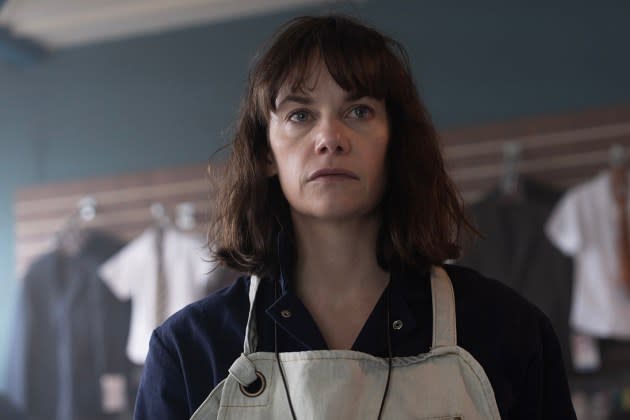‘The Woman in the Wall’ Review: Ruth Wilson and Daryl McCormack Headline a Gripping Showtime Mystery Steeped in Irish Trauma
- Oops!Something went wrong.Please try again later.
- Oops!Something went wrong.Please try again later.

Upon his arrival in the remote Irish town of Kilkinure, detective Colman (Daryl McCormack) cannot help but ask about the hairbrushes he keeps seeing in the windowsills. Massey (Simon Delaney), a local guard, explains they’re meant to ward off the banshee rumored to stalk the area. It’s not that the citizens necessarily believe in spirits, he clarifies: “Doesn’t mean we’re not afraid of them, though.”
But then, this community has more reason than most to fear the wails of mourning women. Showtime’s The Woman in the Wall (which aired on BBC One in the U.K. starting in August) isn’t a ghost story per se, but it’s the tale of a haunting nonetheless — rooted in the very real atrocity of the country’s Catholic-run Magdalene laundries, to harrowing and ultimately quite moving effect.
More from The Hollywood Reporter
Though Colman has come to Kilkinure chasing a lead in the murder of a Dublin priest, his appearance coincides with another mysterious death in the area. On that same morning in late 2015, Lorna (Ruth Wilson) awakens to discover a woman’s corpse in her home and, fearing herself the killer, hastily stashes the body in her walls. For its first couple of hours, The Woman in the Walls unfolds along two separate, occasionally overlapping tracks. Colman’s plays like a gritty detective drama, as he methodically interviews citizens and investigates clues. Lorna’s is a psychological horror about a woman unable to trust her own mind. It’s her perspective that dominates to start, not least because it’s so much more aesthetically and emotionally evocative.
Lorna, we learn, was sent to a Magdalene institution as a pregnant teenager in the 1980s, where she was abused, forced to work and ultimately separated from her baby. Decades later, the trauma still manifests itself in her tendency toward odd, even violent behavior while sleepwalking. The Woman in the Wall never seriously suggests a supernatural influence, but it borrows liberally from genre tropes to convey Lorna’s subjective experience. She hallucinates a nun in the crowd and a crib in the middle of the road. She hears whispers and cries in empty rooms, echoing across decades of anguish. She’s hurled without warning into vivid flashbacks of her most painful memories, and tortured by a constant sense of paranoia.
Given her eccentric reputation, it’s not long before Colman’s suspicions fall on Lorna. The first half of the six-part miniseries dials up the nightmarish dread to a fever pitch as Lorna stays awake for days in terror of what else she might do — and as Colman, himself an adoptee born in a Catholic mother-and-baby home, grows increasingly obsessed with the ugly truth his search uncovers. But just as their cat-and-mouse dynamic comes to a head, The Woman in the Wall abruptly drops most of its spookier, more surreal elements.
Not coincidentally, this happens around the same time that the characters begin to grasp the true breadth of the Church’s cruelty. The free-floating agony of Lorna’s visions coalesce around cold, hard facts, and the murder mysteries take a backseat to the larger conspiracy that links them — so much that by the time the killers are revealed in the finale, the answers register almost as afterthoughts. It’s a bait-and-switch that arguably makes The Woman in the Wall more ambitious and in some ways more haunting, but it’s still one bound to exasperate some viewers expecting less Spotlight and more The Haunting of Hill House.
Plenty of others, though, will find that by the time the shift happens, they’re too invested in these people and their plight not to see it out. To the extent it works, the show is a testament to patient and precise world-building. Kilkinure might be fictional, but the portrait creator Joe Murtagh paints of it has the texture of reality — individuals with prickly personalities or idiosyncratic senses of humor, intricate webs of friendships and grudges, rumors and secrets tracing back years. Likewise, the cast deepen their roles well beyond the few concrete details we get about them. Wilson grounds Lorna’s most dramatic outbursts in a fragility that speaks to a lifetime of trying and mostly failing to keep it together, and McCormack brings out the boyish vulnerability that bridges Colman’s cool exterior and his inner anguish.
Such specificity keeps the characters from getting swallowed up by the symbolic weight of their roles. Colman isn’t the daughter Lorna’s spent her entire adult life grieving, Lorna isn’t the birth mother Colman has wondered about since he was a child. Yet neither can help but see in each other the shape of a familial bond they’d previously only experienced as an unknowable absence, and the drama mines some of its teariest moments from that bittersweet symmetry. But the protagonists hit as hard as they do because the series never loses sight of them as imperfect and uncertain people, rather than universal stand-ins for entire populations.
The Woman in the Wall is not subtle about what’s at stake in tales like the one it’s telling. “If the state were allowed to feel like they’ve gotten away with this, this could happen again,” one woman bitterly remarks in the premiere, lest any viewer miss the point. And there are times, particularly in its tremulously hopeful finale, when the urgency of the show’s themes threatens to overwhelm its plot. But at its most effective, The Woman in the Wall is savvy enough to know that what will keep its message alive long after the end credits (set to a previously unreleased track by real-life Magdalene survivor Sinéad O’Connor) is a truly compelling story. Ghostly bells and spectral whistles and all.
Best of The Hollywood Reporter

